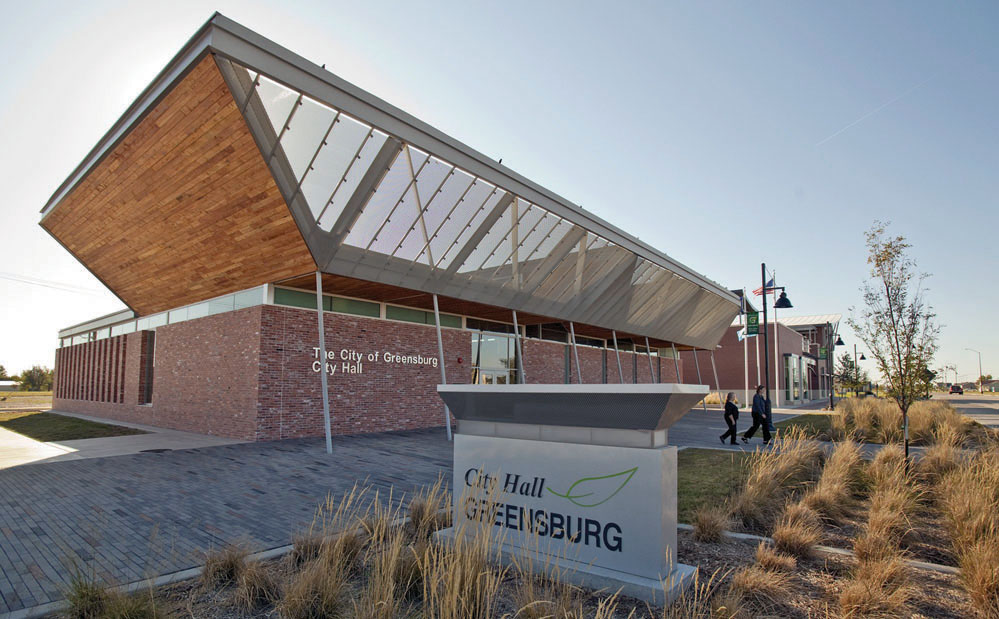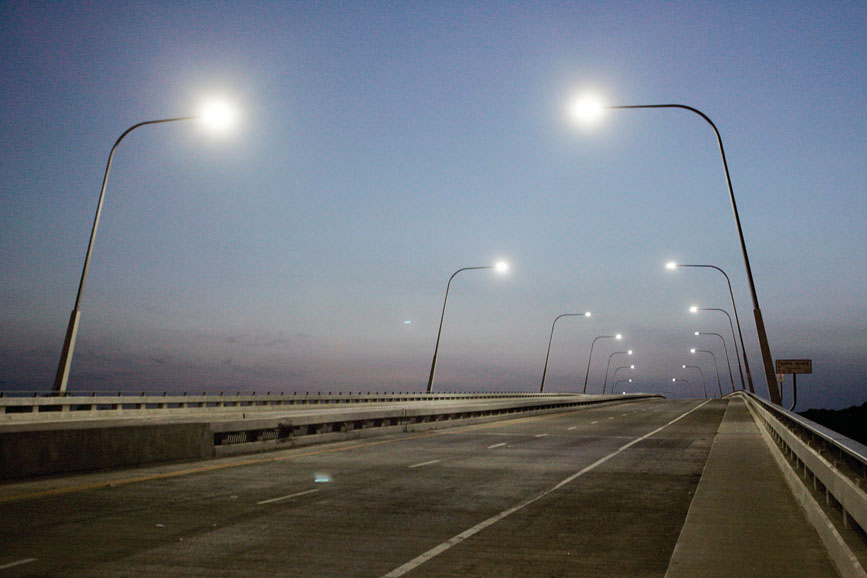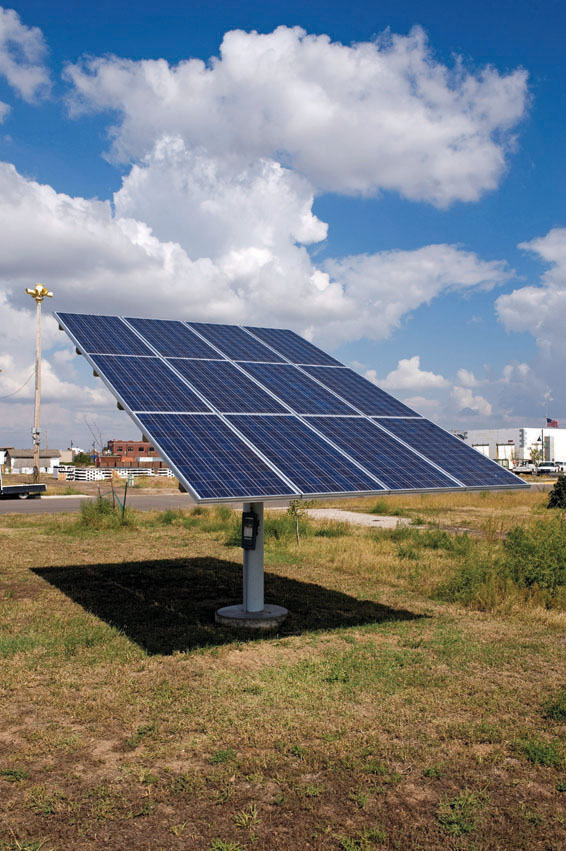PLATINUM RATED
Mike Estes, owner of the local John Deere dealership and service shop, was one of the Greensburg residents who initially resisted the notion of rebuilding green. The 60-year-old Kansas native had “only minimal interest in green building” at first. Then he realized how much money he’d save in energy costs over the years and was ultimately persuaded. With technical assistance provided by the National Renewable Energy Laboratory (NREL) of the U.S. Department of Energy, he rebuilt his dealership to include a suite of green technologies, including solar panels and on-site wind turbines. Since rebuilding, he says he’s saved $25,000 to $30,000 a year in energy costs.
From the beginning, going green was presented to the residents of Greensburg as an opportunity for economic success rather than a financial burden. “We’re very honest and straightforward about getting people the best economic solutions,” says Lynn Billman, a research analyst with NREL who worked closely with residents of Greensburg on their building plans. “We really believe that the best economic solutions can usually be, and often are, green solutions.”
Yes, rebuilding green would cost more in the short term, but in the long term, the savings in energy costs would more than make up for it. Moreover, becoming a pioneer in the green energy movement promised to attract national attention as well as new business to the area, putting Greensburg back on the map with a claim to fame (besides having the world’s largest hand-dug well).
“Before the storm, I couldn’t get business to talk to us about relocating to [Greensburg],” Hewitt told CNN. “Once we went green, our phones starting ringing and opportunities put Greensburg in the game.”
One of the first green things the city council did was pass an ordinance, in December 2007, requiring all new public buildings larger than 4,000 square feet to be built to LEED platinum standards. “LEED” stands for “Leadership in Energy and Environmental Design,” a certification system run by the U.S. Green Building Council, a nonprofit organization that supports sustainable building practices. Platinum is the highest rating a building can achieve, above gold and silver.
GREENSBURG STYLE: LEED PLATINUM BUILDINGS

Greensburg City Hall
LEED Platinum Features
 Solar panels
Solar panels Geothermal heating and cooling
Geothermal heating and cooling Reclaimed brick and wood from buildings destroyed in the tornado
Reclaimed brick and wood from buildings destroyed in the tornado Green roof with vegetation
Green roof with vegetation Rainwater collection and irrigation
Rainwater collection and irrigation 38% more energy efficient
38% more energy efficient

Kiowa, KS, County Schools
LEED Platinum Features
 Natural daylight and ventilation
Natural daylight and ventilation Wind energy generator
Wind energy generator Recycling center
Recycling center Cabinets and lockers made from natural and recycled materials
Cabinets and lockers made from natural and recycled materials Spaces for community sharing
Spaces for community sharing Rainwater collection and irrigation
Rainwater collection and irrigation
LEED-certified buildings must be shown to conserve energy and water, reduce waste sent to landfills, lower greenhouse gas emissions, and be healthier and safer for occupants. By committing to platinum standards, the town agreed to design buildings that would reduce energy consumption by more than 40% over current building code requirements.
“I am so excited about being the first city in the U.S. to adopt this system for a town,” City Administrator Hewitt said after the vote.
RENEWABLE RESOURCES Natural resources that are replenished after use as long as the rate of consumption does not exceed the rate of replacement.
Greensburg now has one of the highest per capita concentrations of LEED-certified buildings in the country, one per every 130 citizens. Among the more than 15 LEED platinum buildings that have been constructed are a new city hall, public school, hospital, art center, and business incubator. The buildings were designed and constructed by a variety of approaches and technologies to achieve their platinum rating, including extensive use of natural light, geothermal heating, solar panels, and even wind turbines. The goal of all these approaches is to reduce energy use overall and end reliance on fossil fuels.

The city ordinance for platinum buildings applies only to public buildings. On the private side, more than half the residents of Greensburg chose to rebuild their homes using green technologies to reduce energy use. An analysis by NREL revealed that more than 100 of the newly built homes would, according to their design plans, use an average of 40% less energy than before, for an average saving of about $512 per year.
In addition to using less energy overall, the residents of Greensburg also chose to have their electricity be “100% renewable, 100% of the time.” They decided to take advantage of a renewable resource that Kansas has in abundance: wind.
On the outskirts of town, a stately row of 10 wind turbines, each more than 200 feet tall, turns slowly and reliably in the breeze. Completed in 2010, the wind farm supplies enough electricity to power about 4,000 households–enough for all of Greensburg and dozens of neighboring towns.
GREENSBURG STYLE: NET-ZERO ENERGY
Greensburg Wind Farm
 100% renewable energy
100% renewable energy Powers the entire city
Powers the entire city Greensburg uses 25%–33% of the power generated from 10 turbines. Remaining energy goes to powering neighboring towns.
Greensburg uses 25%–33% of the power generated from 10 turbines. Remaining energy goes to powering neighboring towns.

100% LED Streetlights
 40% more efficient than traditional fixtures
40% more efficient than traditional fixtures 70% total energy and maintenance savings
70% total energy and maintenance savings Reduce nighttime light pollution by pointing straight downward
Reduce nighttime light pollution by pointing straight downward

Solar Energy
 100% renewable energy
100% renewable energy Many individual homes and buildings have a collection of solar panels.
Many individual homes and buildings have a collection of solar panels. Additional panels on roofs and walls or in vacant fields
Additional panels on roofs and walls or in vacant fields
Other renewables at work in Greensburg include LED (light-emitting diode) lamps that illuminate city streets. Greensburg is the first city in the United States to use LEDs for 100% of its street lighting. LED lamps are 40% more efficient than regular streetlamps, and also help avoid light pollution because they are easier to direct in only one direction: down.
With all these changes, Greensburg has effectively achieved its energy goal. It is a net-zero energy city, generating as much electricity from renewable energy as it uses. “Greensburg has the best infrastructure of any community in the world right now,” Hewitt says proudly.